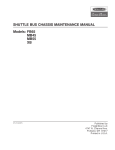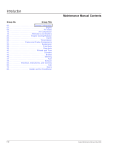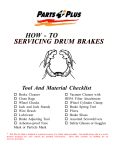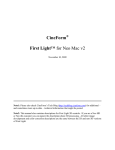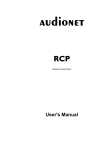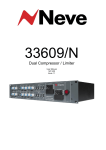Download Eaton Fuller Pull-Type Clutches
Transcript
25.01 Eaton Fuller Pull-Type Clutches Clutch Adjustments NOTE: The following procedures apply only to Eaton® Fuller® Easy-Pedal® and Stamped Angle Spring clutches. Solo™ clutches are adjustmentfree. Release Bearing Travel (synchronized transmissions) mm) in order for the release-bearing to release properly. For a dual-disc clutch, this clearance must be 3/4 inch (19 mm) in order for the release-bearing to release properly. See Fig. 2. If the release bearing clearance is not within the specifications, then an adjustment is needed. Go to "Adjustment" in this section. 1 Measurement IMPORTANT: Do not skip steps in the adjustment operations. Internal adjustments must be correct before making any linkage adjustments for pedal free play. Incorrect adjustments can cause transmission gear clash, and slipping and burning of clutch components. 1. Apply the parking brakes, and chock the front tires. 2. Remove the clutch inspection cover from the bottom of the transmission clutch housing. See Fig. 1. 10/12/94 A f250198c A. Release-Bearing Clearance: Single-Disc, 1-7/8 inch (48 mm); Dual-Disc, 3/4 inch (19 mm). 1. Release Bearing Fig. 2, Release Bearing Clearance 4. If the release bearing clearance measurement is okay, check and adjust the clutch linkage. For instructions, see Section 25.02. 1 Adjustment Angle-Spring and Easy-Pedal clutches are adjusted with either a lockstrap (Fig. 3), or with the KwikAdjust® mechanism (Fig. 4). Clutches with a Lockstrap 03/01/94 f250002a 1. Clutch Inspection Cover Fig. 1, Remove the Clutch Inspection Cover NOTE: When checking release bearing clearance, remove the free travel by lightly pulling the release fork against the clutch release bearing. This eliminates any bearing movement. 3. Measure the clearance between the release bearing and the clutch cover. For a single-disc clutch, this clearance must be 1-7/8 inch (48 Business Class Trucks Service Manual, Supplement 31, October 2004 1. Turn the engine flywheel until the lockstrap is aligned with the clutch inspection-cover opening. See Fig. 1 and Fig. 3. 2. Remove the lockstrap. See Fig. 3. 3. Release the clutch by depressing the pedal. Block the pedal in the released position, or have someone assist you by holding the pedal down during the adjustment procedure. 4. Using a clutch adjusting tool, turn the adjusting ring clockwise to move the release bearing toward the transmission, or counterclockwise to move the release bearing toward the engine. 100/1 25.01 Eaton Fuller Pull-Type Clutches Clutch Adjustments clutch, when the clearance is 3/4 inch (19 mm), the internal adjustment is complete. 6. Install the lockstrap, and tighten the bolt 35 to 40 lbf·ft (47 to 54 N·m). 1 IMPORTANT: Use the same length bolt when installing the lockstrap. A longer bolt will lock-up the clutch assembly. 2 03/01/94 f250005a 1. Adjusting Ring 2. Lockstrap NOTE: If the lockstrap will not engage the notches of the adjusting ring, check the clutch assembly for worn parts. For instructions, see Subject 120. 7. If the release bearing clearance measurement is okay, check and adjust the clutch linkage. For instructions, see Section 25.02. Clutches with Kwik-Adjust Fig. 3, Clutch Equipped with a Lockstrap 1. Turn the engine flywheel until the lockstrap is aligned with the clutch inspection-cover opening. See Fig. 1 and Fig. 4. 2. Release the clutch by depressing the pedal. Block the pedal in the released position, or have someone assist you by holding the pedal down during the adjustment procedure. NOTE: An open-end wrench is not recommended for the following step. 3. Insert a 12 point 3/4-inch socket or box-end wrench through the inspection cover opening. Depress the square bolt to adjust the releasebearing clearance. 03/01/94 f250162a Fig. 4, Clutch Equipped with Kwik-Adjust NOTE: Each notch in the adjusting ring represents about 0.020-inch (0.5-mm) releasebearing travel. Thus, three notches moved means 0.060 inch (1.5 mm) or about 1/16-inch release-bearing travel. 5. After adjusting, release the pedal, and check the clearance between the release-bearing housing and the clutch cover. For a single-disc clutch, when the clearance is 1-7/8 inch (48 mm), the internal adjustment is complete. For a dual-disc 100/2 Rotate the adjusting ring counterclockwise to move the release-bearing toward the engine. Rotate the adjusting ring clockwise to move the release-bearing toward the transmission. Be sure the adjustment bolt is locked when you have completed the adjustment. NOTE: Each quarter of a turn of the adjustment bolt represents about 0.017-inch (0.4-mm) release-bearing movement. 4. After adjusting, release the pedal, and check the internal clearance between the release-bearing housing and the clutch cover. For a single-disc clutch, when the internal clearance is 1-7/8 inch (48 mm), the adjustment is complete. For a dualdisc clutch, when the internal clearance is 3/4 inch (19 mm), the adjustment is complete. Business Class Trucks Service Manual, Supplement 31, October 2004 25.01 Eaton Fuller Pull-Type Clutches Clutch Adjustments 5. If the release bearing clearance measurement is okay, check and adjust the clutch linkage. For instructions, see Section 25.02. Release Bearing Travel (nonsynchronized transmissions) 1 Measurement IMPORTANT: Do not skip steps in the adjustment operations. Internal adjustments must be correct before making any linkage adjustments for pedal free-travel. Incorrect adjustments can cause transmission gear clash, and slipping and burning of clutch components. 1. Apply the parking brakes, and chock the front tires. 2. Remove the clutch inspection cover from the bottom of the transmission clutch housing. See Fig. 1. 2 03/01/94 f250003a 1. Transmission Input Shaft Bearing Cap 2. Clutch Brake Discs and Washer Fig. 5, Position the Clutch Brake 3. Slide the clutch-brake discs and washer, or torque-limiting clutch brake, tight against the transmission input shaft bearing cap. See Fig. 5. Also, slide the release-bearing as far as possible towards the transmission. 1 4. Measure the internal clearance between the aft face of the release-bearing and the forward face of the clutch brake disc, or torque-limiting clutch brake. This internal clearance must be 1/2 inch to 9/16 inch (12.7 mm to 14.3 mm) in order for the release-bearing to release properly. See Fig. 6. IMPORTANT: An inspection tool A02–12419 (available through the PDCs) can be used to check the distance between the release-bearing and the clutch brake. See Fig. 7. One end of the tool has green tape on it and is 0.50 inch (12.7 mm) in diameter; the other end has blue tape on it and is 0.56 inch (14.3 mm) in diameter. 5. If using tool A02–12419 to check the distance between the release-bearing and the clutch brake, position the tool so that the legs straddle the transmission input shaft. Check the gap with both ends of the tool as follows: Business Class Trucks Service Manual, Supplement 31, October 2004 A B f250172b 08/16/94 A. Release-travel: 1/2 to 9/16 inch (12.7 to 14.3 mm). B. Free-travel 0.105 to 0.145 inch (2.7 to 3.7 mm) between yoke and wear pads. 1. Clutch Brake Fig. 6, Clutch Travel Adjustments 5.1 Insert the blue 0.56-inch (14.3-mm) end. If it fits loosely, the gap is too wide and ad- 100/3 25.01 Eaton Fuller Pull-Type Clutches Clutch Adjustments A B A B 03/26/96 f580133 A. 0.50 inch (12.7 mm) B. 0.56 inch (14.3 mm) A B Fig. 7, Inspection Tool A02-12419 justment is needed. Go to "Adjustment" in this section. 5.2 5.3 If the blue 0.56-inch (14.3-mm) end can’t be inserted in the gap, then try to insert the green 0.50-inch (12.7-mm) end. If the green end of the tool fits, snug or loose, then no adjustment is needed. If the green end of the tool can’t be inserted in the gap, adjustment is needed. Go to "Adjustment" in this section. IMPORTANT: An inspection tool A02–12254 (available through the PDCs) can be used to check the distance between the release-bearing and the release yoke (free travel). See Fig. 6 and Fig. 8. The legs on one end of the tool have green tape on them and are 0.105 inch (2.7 mm) thick; the legs on the other end have blue tape on them and are 0.145 inch (3.7 mm) thick. 03/26/96 f580132 A. 0.105 inch (2.7 mm) B. 0.145 inch (3.7 mm) Fig. 8, Inspection Tool A02-12254 6.3 If the green end of the tool can’t be inserted in the gap, the gap is too narrow and linkage adjustment is needed. For instructions, see Section 25.02. Adjustment Angle-Spring and Easy-Pedal clutches are adjusted with either a lockstrap (Fig. 9), or with the KwikAdjust® mechanism (Fig. 10). 6. If using tool A02–12254 to check the distance between the release-bearing and the release yoke, position the tool so it straddles the yoke to ensure that there won’t be any misalignment. Check the distance with both ends of the tool as follows: 6.1 6.2 100/4 1 Insert the blue 0.145-inch (3.7-mm) end. If it fits loosely, the gap is too wide and linkage adjustment is needed. For instructions, see Section 25.02. If the blue 0.145-inch (3.7-mm) end can’t be inserted in the gap, then try to insert the green 0.105-inch (2.7-mm) end. If the green end of the tool fits, snug or loose, then no adjustment is needed. 2 03/01/94 f250005a 1. Adjusting Ring 2. Lockstrap Fig. 9, Clutch Equipped with a Lockstrap Business Class Trucks Service Manual, Supplement 31, October 2004 Eaton Fuller Pull-Type Clutches 25.01 Clutch Adjustments 5. After adjusting, release the pedal, and check the clearance between the release-bearing housing and the forward clutch brake disc, or torquelimiting clutch brake. When the clearance is 1/2 inch to 9/16 inch (12.7 mm to 14.3 mm), the adjustment is complete. 6. Install the lockstrap, and tighten the bolt 35 to 40 lbf·ft (47 to 54 N·m). IMPORTANT: Use the same length bolt when installing the lockstrap. A longer bolt will lock-up the clutch assembly. 03/01/94 f250162a Fig. 10, Clutch Equipped with Kwik-Adjust NOTE: If the lockstrap will not engage the notches of the adjusting ring, check the clutch assembly for worn parts. For instructions, see Subject 120. 7. Check and adjust the clutch linkage. For instructions, see Section 25.02. Clutches with a Lockstrap Clutches with Kwik-Adjust 1. Turn the engine flywheel until the lockstrap is aligned with the clutch inspection-cover opening. See Fig. 1 and Fig. 9. 1. Turn the engine flywheel until the lockstrap is aligned with the clutch inspection-cover opening. See Fig. 1 and Fig. 10. 2. Remove the lockstrap. See Fig. 9. 2. Release the clutch by depressing the pedal. Block the pedal in the released position, or have someone assist you by holding the pedal down during the adjustment procedure. 3. Release the clutch by depressing the pedal. Block the pedal in the released position, or have someone assist you by holding the pedal down during the adjustment procedure. 4. Using a clutch adjusting tool, turn the adjusting ring to adjust release travel (the clearance between the release-bearing housing and the forward clutch brake disc). If clearance between the release-bearing housing and the clutch brake is less than 1/2 inch (12.7 mm), rotate the adjusting ring counterclockwise to move the release-bearing toward the engine. If clearance between the release-bearing housing and the clutch brake is more than 9/16 inch (14.3 mm), rotate the adjusting ring clockwise to move the release-bearing toward the transmission. The lockstrap bolt may be installed and used as a fulcrum in turning the adjusting ring. NOTE: Each notch in the adjusting ring represents about 0.020-inch (0.5-mm) releasebearing travel. Thus, three notches moved means 0.060-inch (1.5-mm) or about 1/16-inch release-bearing travel. Business Class Trucks Service Manual, Supplement 31, October 2004 NOTE: An open-end wrench is not recommended for the following step. 3. Insert a 12 point 3/4-inch socket or box-end wrench through the inspection cover opening. Depress the square bolt to adjust the releasebearing clearance. If clearance between the release-bearing housing and the clutch brake is less than 1/2 inch (12.7 mm), rotate the adjusting ring counterclockwise to move the release-bearing toward the engine. If clearance between the release-bearing housing and the clutch brake is more than 9/16 inch (14.3 mm), rotate the adjusting ring clockwise to move the release-bearing toward the transmission. Be sure the adjustment bolt is locked when you have completed the adjustment. NOTE: Each quarter of a turn of the adjustment bolt represents about 0.017-inch (0.4-mm) release-bearing movement. 100/5 25.01 Eaton Fuller Pull-Type Clutches Clutch Adjustments 4. After adjusting, release the pedal, and check the clearance between the release-bearing housing and the forward clutch brake disc, or torquelimiting clutch brake. When the clearance is 1/2 inch to 9/16 inch (12.7 mm to 14.3 mm), the adjustment is complete. 1 2 5. Check and adjust the clutch linkage. For instructions, see Section 25.02. Self-Adjusting Clutch IMPORTANT: The self-adjusting clutch normally compensates for wear, and should only need adjustment when it is first installed. If the release-bearing clearance check shows the selfadjusting clutch to be out of adjustment, be sure that: A. the actuator arm is correctly inserted into the release-bearing sleeve retainer (see Fig. 11); B. the adjuster arm is not bent; 03/01/94 C. the release-bearing has a 1/2 inch to 9/16 inch (12.7 mm to 14.3 mm) travel; 1. Actuator Arm 2. Release-Bearing Sleeve Retainer D. other clutch parts (such as the adjusting ring) aren’t frozen or damaged. f250006a Fig. 11, Correct Actuator Arm Insertion B If the clutch is damaged, replace it. A If adjustment is needed, do the following: 1. Turn the engine flywheel until the adjuster assembly is in line with the clutch inspection-cover opening. See Fig. 1 and Fig. 11. 2. Remove the right-side bolt from the adjuster assembly, and loosen the left-side bolt one turn. See Fig. 12. 3. To allow manual adjustment, rotate the adjuster assembly upward. See Fig. 13. This will disengage the adjuster worm gear from the adjusting ring. Hold the adjuster assembly disengaged, and tighten the left-side bolt. 4. Release the clutch by depressing the pedal; block it in this position. 5. Using a clutch adjusting tool in the lower teeth, turn the adjusting ring clockwise to move the release-bearing toward the transmission, or counterclockwise to move the release-bearing toward the engine. See Fig. 11. 100/6 1 2 03/01/94 f250007a A. Loosen this bolt. B. Remove this bolt. 1. Adjuster Assembly 2. Adjusting Ring Fig. 12, Remove the Right-Side Bolt Business Class Trucks Service Manual, Supplement 31, October 2004 25.01 Eaton Fuller Pull-Type Clutches Clutch Adjustments to mesh. Install the right-side bolt, and tighten both bolts 30 to 35 lbf·ft (41 to 47 N·m). 1 C B 8. Visually check that the actuator arm is inserted in the release-bearing sleeve retainer. See Fig. 9. If the adjuster assembly is installed correctly, the adjuster assembly spring will move back and forth as the clutch pedal is depressed and released. IMPORTANT: The clutch will not self-adjust if the actuator arm is not correctly inserted in the release-bearing sleeve retainer. A 03/01/94 A. B. C. D. After making release-bearing adjustments, check and adjust the clutch linkage. For instructions, see Section 25.02. D f250008a Do not pry on the innermost teeth. Tighten the bolt. Rotate up. Use a clutch adjusting tool in the lower teeth. 1. Adjuster Assembly Fig. 13, Rotate the Adjuster Assembly CAUTION Do not pry on the innermost gear teeth of the adjusting ring. See Fig. 13. Doing so could damage the teeth, and prevent the clutch from selfadjusting. NOTE: Each lower gear tooth of the adjusting ring represents about 0.010-inch (0.25-mm) release-bearing movement. Thus, six notches moved means 0.060-inch (1.5-mm) or about 1/16-inch release-bearing movement. 6. After adjusting, release the clutch pedal, and check the clearance between the release-bearing housing and the forward clutch brake disc, or torque-limiting clutch brake. When the clearance is 1/2 inch to 9/16 inch (12.7 mm to 14.3 mm), the adjustment is complete. IMPORTANT: The clutch will not self-adjust if release-bearing travel is less than 1/2 inch (12.7 mm). 7. Loosen the left-side adjuster bolt, and rotate the adjuster assembly down, meshing the adjuster worm gear with the adjusting ring teeth. The ring may have to be moved slightly, to allow the worm Business Class Trucks Service Manual, Supplement 31, October 2004 100/7







